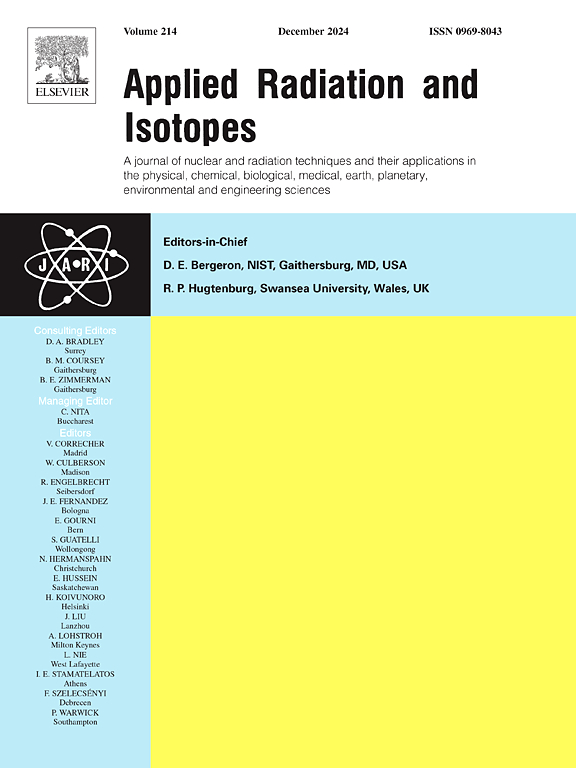Background simulation of a low background gamma ray spectrometer with an array of five germanium detectors
IF 1.6
3区 工程技术
Q3 CHEMISTRY, INORGANIC & NUCLEAR
引用次数: 0
Abstract
A new gamma ray spectrometer with an array of five germanium detectors, called ARGUS, is designed to screen and select materials used in rare-event search experiments. In this paper, we investigate the background characteristics of ARGUS using Monte Carlo simulation. The expected background count rate was found to reach the level of 10 counts per day per kg of germanium crystal (cpkd) in the energy region of 60 keV to 2700 keV. The minimum detectable activity (MDA) for germanium array was estimated via the maximum likelihood method. With an 100-day measurement of a 118.3 kg high purity copper sample, the MDA were calculated to be 28.8 Bq/kg for 212Pb (238 keV) and 32.8 Bq/kg for 214Bi (609 keV). The ARGUS is planned to be built in the China Jinping Underground Laboratory in 2025.
具有5个锗探测器阵列的低本底伽马射线谱仪的背景模拟
一种名为ARGUS的新型伽马射线光谱仪配备了5个锗探测器阵列,旨在筛选和选择用于罕见事件搜索实验的材料。本文采用蒙特卡罗仿真方法研究了ARGUS的背景特性。在60 keV到2700 keV的能量范围内,期望的背景计数率达到每千克锗晶体(cpkd)每天10个计数的水平。通过极大似然法估计锗阵列的最小可检测活性(MDA)。通过对118.3 kg高纯铜样品进行100天的测量,计算出212Pb (238 keV)的MDA为28.8 μBq/kg, 214Bi (609 keV)的MDA为32.8 μBq/kg。
本文章由计算机程序翻译,如有差异,请以英文原文为准。
求助全文
约1分钟内获得全文
求助全文
来源期刊

Applied Radiation and Isotopes
工程技术-核科学技术
CiteScore
3.00
自引率
12.50%
发文量
406
审稿时长
13.5 months
期刊介绍:
Applied Radiation and Isotopes provides a high quality medium for the publication of substantial, original and scientific and technological papers on the development and peaceful application of nuclear, radiation and radionuclide techniques in chemistry, physics, biochemistry, biology, medicine, security, engineering and in the earth, planetary and environmental sciences, all including dosimetry. Nuclear techniques are defined in the broadest sense and both experimental and theoretical papers are welcome. They include the development and use of α- and β-particles, X-rays and γ-rays, neutrons and other nuclear particles and radiations from all sources, including radionuclides, synchrotron sources, cyclotrons and reactors and from the natural environment.
The journal aims to publish papers with significance to an international audience, containing substantial novelty and scientific impact. The Editors reserve the rights to reject, with or without external review, papers that do not meet these criteria.
Papers dealing with radiation processing, i.e., where radiation is used to bring about a biological, chemical or physical change in a material, should be directed to our sister journal Radiation Physics and Chemistry.
 求助内容:
求助内容: 应助结果提醒方式:
应助结果提醒方式:


